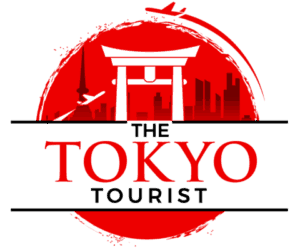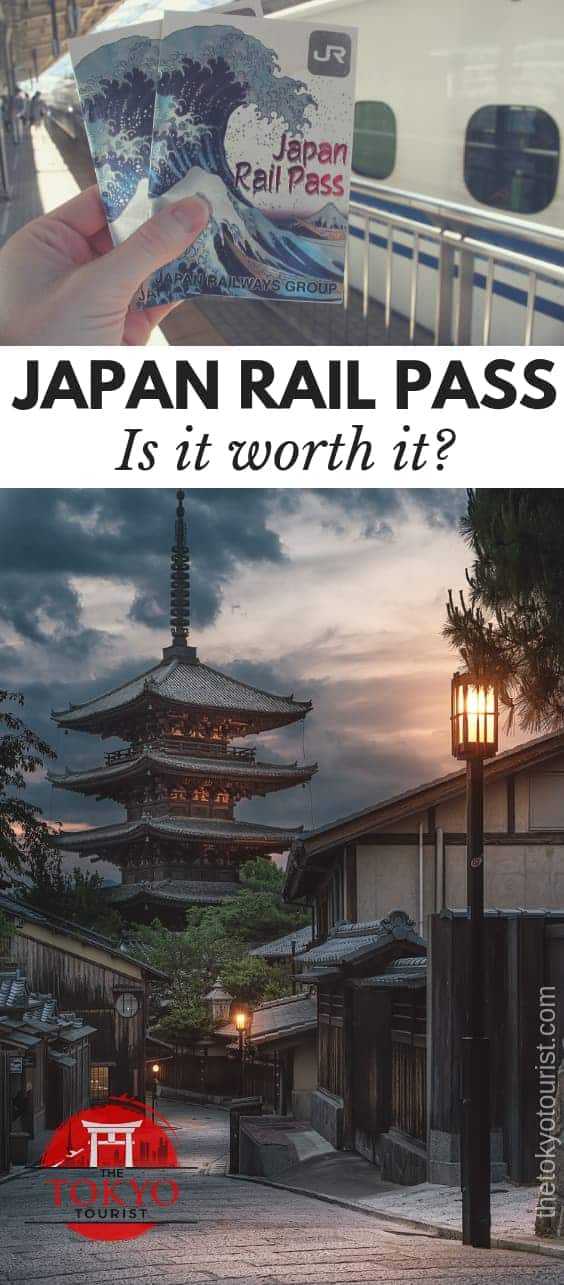Deprecated: mb_convert_encoding(): Handling HTML entities via mbstring is deprecated; use htmlspecialchars, htmlentities, or mb_encode_numericentity/mb_decode_numericentity instead in /home2/thetoky7/public_html/wp-content/themes/acabado/functions.php on line 2119
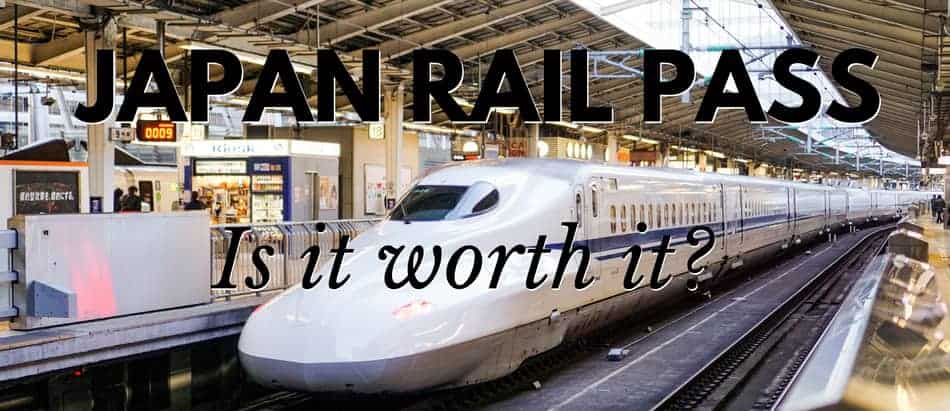
Updated: September 2019
To Japan Rail Pass, or not to Japan Rail Pass, that is the question! Fortunately, the answer is quite simple. Is a Japan Rail Pass Worth it? Yes, it is if you plan to travel by train for at least $260 (¥29,110) in 7 days. This is one of the most common itineraries for tourists in Japan:
- Narita Airport → Tokyo
- Tokyo → Kyoto
- Kyoto → Nara
- Nara → Kyoto
- Kyoto → Tokyo
- Tokyo → Narita Airport
If this is your itinerary, a Japan Rail Pass is worth it. You’ll save about ¥4,000 ($40). Stick a few more train journeys in there, and you will save a lot more!
Want to read about my INSANE savings with the JR Pass? Jump down!
What is a Japan Rail Pass?
A JR Pass is the most cost-effective all year* round travel alternative for tourists planning to travel a fair amount by train in Japan. It gives you an unlimited amount of train journeys within a set number of days, depending on the type of JR Pass you buy. You get access to the Shinkansen network, express/local trains and more.
* Not in a rush? Not bothered by speed? You should really check out the Seishun 18 ticket. It is the cheapest way to travel in Japan but you can only use it specific times of the year. Check out if it lines up with your trip.
Don’t need a JR Pass? Only want to know the best ways of getting to Osaka and Kyoto from Tokyo? Check out these articles:
Six Different Types of JR Passes
This sounds like a lot but it’s not complicated, and if you have your itinerary ready you should have no problems finding the right JR Pass for you. It’s quite simple: You need to choose duration + comfort. That is 3 * 2 options.
There are three different durations to chose from:
- 7 days (consecutive)
- 14 days (consecutive)
- 21 days (consecutive)
If you’re only staying in Japan for a week, this is a no-brainer. If you’re staying for 14 days, I would consider condensing most of my travel to a 7-day period so I could get the cheaper 7-day pass. Do you have plans to travel by train throughout your 14-day stay, you should probably go for the 14-day pass.
There are two comfort levels:
- Standard pass
- Green pass (1st class)
Standard seats on trains in Japan are of good quality. They’re usually comfortable, and they’re more spacious than your typical airline seats. Although I prefer to travel in a green car (1st class), you’ll be quite comfortable in the standard cars. The green pass is more of a luxury option if you want to splurge or somewhat of a necessity if you want to guarantee seats in the peak season.
Green seats are larger than the regular seats, and they come with a footrest. There is more room between the seat rows, and you can recline your seat 40°. You get more frequent service, and on some lines, the onboard staff will offer you a traditional oshibori (small hot towel). The cars with green seats are usually less crowded, and you should consider buying a Green pass if you’re going to Japan between June and September. This is the peak season for both tourists and locals to use the trains, due to all the festivals and national celebrations.
Speaking of service, did I mention they serve beer on Shinkansen trains? 🙂
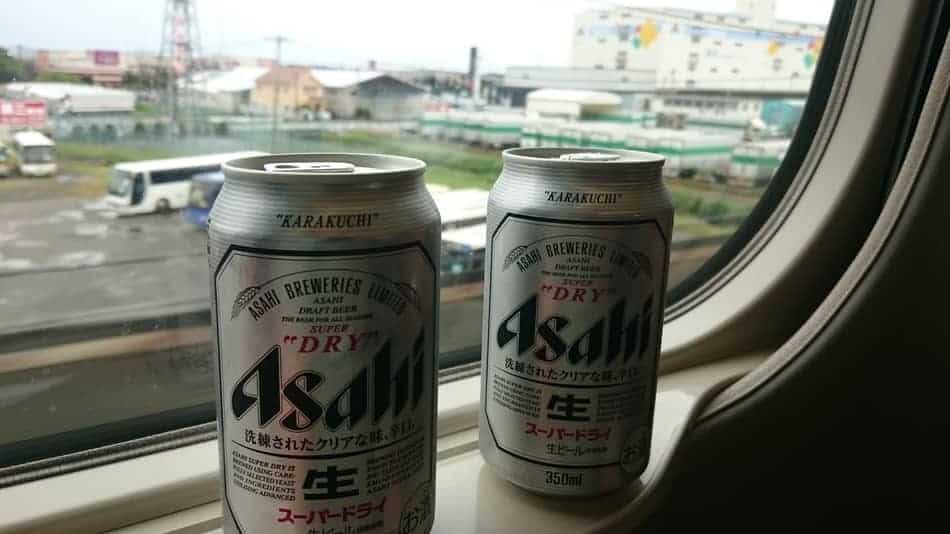
How Much Does a Japan Rail Pass Cost?
Let’s take a quick look at the prices. It may seem rather expensive at first but remember that Shinkansen is a high-end mode of transportation. And if you buy single tickets as you go, you’ll easily spend more than what a 7-day pass costs.
($1 = ¥112 / September 2019)
[table id=6 responsive=scroll /]
Children under the age of 6 are free if they don’t occupy a seat. Children ages 6-11 get 50% off.
Who Can Buy a Japan Rail Pass?
So who is eligible for the Japan Rail Pass? The JR Pass is designed for tourists and the only people allowed to purchase and use it are short-term visitors. Inhabitants in Japan can only dream of using this great offer.
When you arrive in Japan as a tourist, you’ll get a Temporary Visitor Visa. It allows you to stay in the country for up to 90 days and you are not allowed to engage in any paid activities.
If you are a Japanese national and can prove you have been living abroad for the last ten years, you’re also eligible for a JR Pass.
How Do You Buy a Japan Rail Pass?
Earlier you could only buy a Japan Rail Pass online, but right now there’s a trial period where you’re able to buy a JR Pass at a limited number of locations in Japan. But buying the pass in Japan is about 15% more expensive, so my advice is just to order it online. I’ve done it a bunch of times and never had any problems with it. Not only is it cheaper but it’s also a lot easier.
By the way, when I say “buy a JR Pass” I’m actually talking about an exchange voucher you have to turn in to get your actual JR Pass, once you get to Japan. There’s no way to get the actual JR Pass mailed to you. But don’t worry, it’s easy to transform your exchange voucher into a JR Pass. I’ll walk you through it in a minute.
What should you consider when deciding where to buy the Japan Rail Pass online? Here are a few tips.
- Use an official vendor
- There are some small differences in price, so choose the cheapest one
- Pick one with a free shipping option
- Easy-to-use website
- Use a vendor with a long and excellent track record
I use www.jrailpass.com (I’ve been linking to it throughout) which is not only the cheapest but also the most reputable vendor. They have safe payment with secure servers, and the delivery is fast and cheap. The shipping is even free if you order for the minimum amount. Along with your ticket purchase, you’ll also get a free “JR Pass Guide.” But since you’re reading this guide, you probably won’t need it. 🙂
I’ve ordered from them many times and never had any problems. But one time I made a mistake when I purchased Japan Rail Passes for a group of friends. The name on the JR Pass needs to be identical to the name in the passport, but somehow I misspelled it. I contacted jrailpass.com, and they corrected my spelling mistake right away. That’s the only time I’ve needed to reach out to them, so I don’t have a lot of experience with their support, but at least that time it was professional and fast.
I also like them because they have a straightforwardly and easy-to-use website. Click, click, order, sit back and wait for the mail!
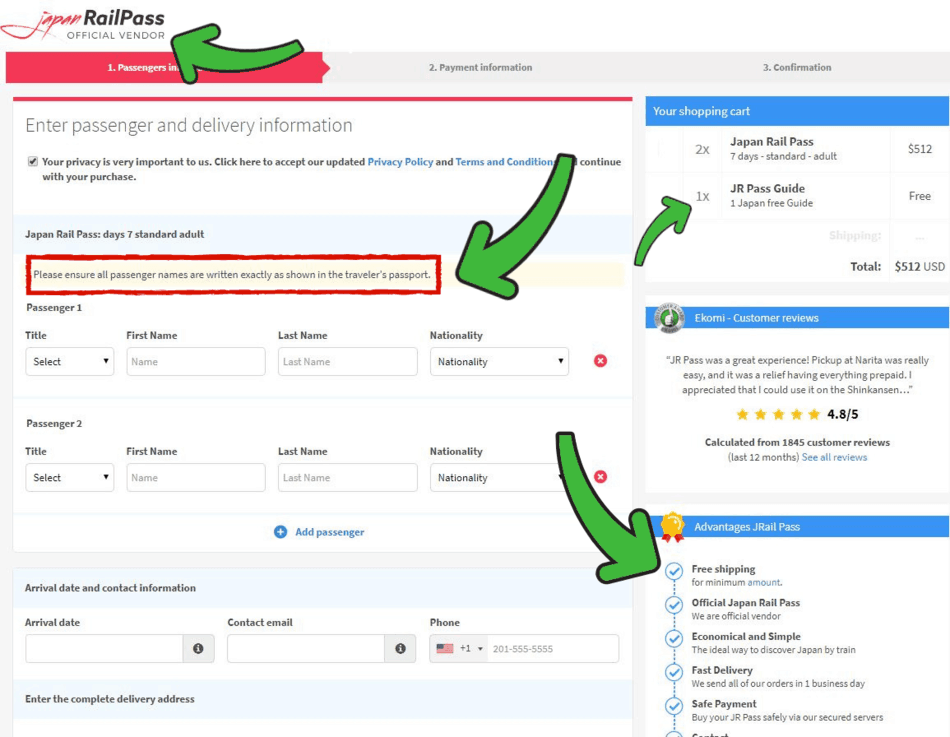
How to Activate Your JR Pass / Exchange Your Voucher for a Rail Pass
Like I said, after buying your JR Pass you actually don’t get the pass itself mailed to you, you get an exchange voucher. This is the case for every JR Pass vendor including jrailpass.com. Once you arrive in Japan, you’ll be able to exchange your exchange voucher for the real Japan Rail Pass.
You need to head to a JR Agency (JR Sales Office / JR Service Senter / JR Exchange Office) to transform your voucher into the real deal. You can find Japan Rail Offices in Narita and Haneda Airport and all the major cities. In the small guide you receive in the mail with your exchange voucher there’s a handy map showing the locations of some of the relevant JR agencies.
Most of you will be landing at either Narita Airport or Haneda Airport so I would suggest you get your pass there. Although it’s usually a bit crowded so if you’re not using your JR Pass for the Narita Express you can put the exchange off until you get to Tokyo. You can turn in your exchange voucher in Shinjuku, Shibuya, Ueno, and a bunch of other locations. I’ve actually listed all of them in the collapsible list below.
[expand title=”Click here to see all the JR Ticket Offices“]
- Kushiro Station
- Obihiro Station
- Asahikawa Station
- Sapporo Station
- New Chitose Airport Station
- Hakodate Station
- Hachinohe Station
- Sendai Station
- Yamagata Station
- Fukushima Station
- Niigata Station
- Kanazawa Station
- Narita Airport Terminal 1 Station
- Narita Airport Terminal 2·3 Station
- Haneda Airport International Terminal Station*
- Tokyo Station
- Ueno Station
- Shinjuku Station
- Shibuya Station
- Ikebukuro Station
- Shinagawa Station
- Yokohama Station
- Shin-Yokohama Station
- Odawara Station
- Mishima Station
- Shizuoka Station
- Hamamatsu Station
- Nagoya Station
- Kyoto Station
- Shin-Ōsaka Station
- Ōsaka Station
- Kansai Airport Station
- Sannomiya Station
- Okayama Station
- Hiroshima Station
- Shimonoseki Station
- Takamatsu Station
- Matsuyama Station
- Kokura Station
- Hakata Station
- Nagasaki Station
- Kumamoto Station
- Ōita Station
- Miyazaki Station
- Kagoshima-Chūō Station
- Nara Station
- Higashi-Maizuru Station
- Nishi-Maizuru Station
- Tottori Station
- Sakaiminato Station
- Shin-Yamaguchi Station
- Shin-Hakodate-Hokuto Station
- Higashi-Maizuru Station
- Nishi-Maizuru Station[/expand]
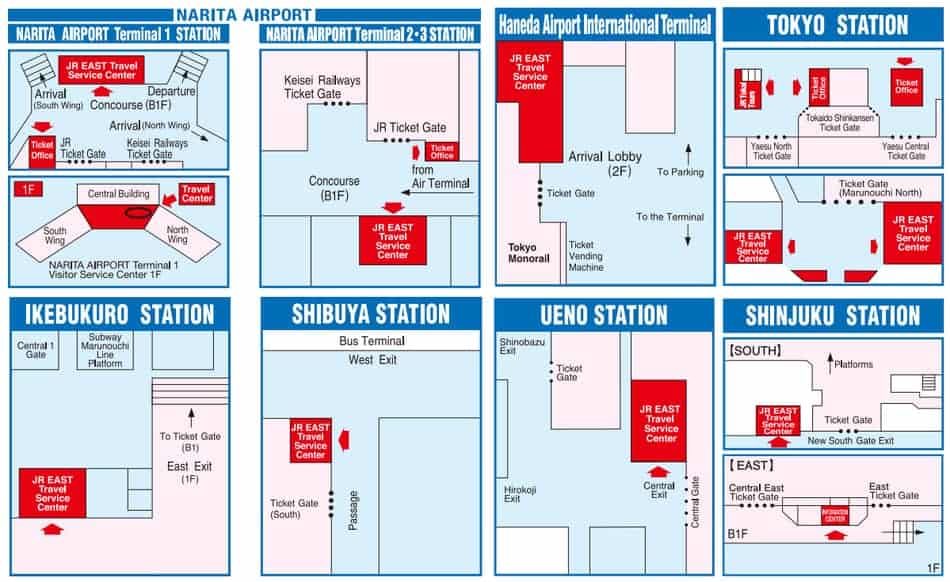 When you’re at a JR agency, you need to fill out a simple form with your name, nationality, etc. Fill out the form BEFORE you head to the counter to give it to the desk clerk. But pay attention, here’s the most important thing: On the form, they also ask to fill in the “first day of use.” The JR Pass will be valid from the date you put down as the first day of use and the next 7/14/21 consecutive days, depending on the duration of your Japan Rail Pass. You will not be able to use the pass before the first day of use, and you will not be able to change the date once you set it.
When you’re at a JR agency, you need to fill out a simple form with your name, nationality, etc. Fill out the form BEFORE you head to the counter to give it to the desk clerk. But pay attention, here’s the most important thing: On the form, they also ask to fill in the “first day of use.” The JR Pass will be valid from the date you put down as the first day of use and the next 7/14/21 consecutive days, depending on the duration of your Japan Rail Pass. You will not be able to use the pass before the first day of use, and you will not be able to change the date once you set it.
Congrats, now you have your official JR Pass! Take good care of it because if you lose it, it cannot be refunded for any reason.
How Do You Reserve Seats With a JR Pass?
First of all: You don’t have to reserve seats. Usually, you can just jump on a car with non-reserved seats. If all the non-reserved seats are occupied, you’ll have to stand until something opens up. If you’re traveling as a group and you want to sit together, you should reserve seats.
Seat reservations are included in both the standard and the green JR Pass. As you know with the pass you’re eligible for an unlimited amount of train journeys 24/7 for a set number of days. To reserve a seat, you just have to let Japan Railways know when you’re traveling!
Here’s what you do: Go to any ticket office and present your JR Pass and specify your destination and your approximate departure hour. The staff is accommodating and will help you find the best departure time for you. If you already know the exact train you’re traveling with, just say something like: “I would like to reserve a seat for Kyoto on Shinkansen leaving 12:05 p.m. tomorrow, please.” Then you’ll get your reserved seat ticket, and you’re all set.
But keep in mind, there are a limited amount of seats available for reservation, so if you’re traveling as a large group, it’s not guaranteed you’ll be able to sit together. This is especially true if you make your reservation close to the departure and during the peak season (June to September). In fact, a couple of years ago I was going from Tokyo to Kyoto by myself but was unable to reserve a seat on my preferred train because it was fully booked. But as you all know the Japanese railway system is incredible and the departures are very frequent, so I just hopped on the next train which left something like 12 minutes later.
Pro tip 1: Use HyperDia to plan your train journeys and print out all the information and hand it to the service person at the counter. The desk clerk can now reserve seats on all the trains you plan to ride in a swift and orderly fashion. This way you can reserve seats for your whole travel itinerary in just a matter of seconds.
Pro tip 2: If you’re going from Tokyo to Kyoto, be sure to reserve a seat on the right side of the train so you’ll get a great view of Mount Fuji. (Left side when going the other way. Duh!)
How Do I Find My Reserved Seat?
If you have a reserved seat, the car and seat number are clearly stated on your ticket. And no, you don’t have to know any kanji! On the monitors on the platforms, you can see where the different cars stop so now you just have to find the right area of the platform and wait for your train – which is almost always on time.
The trains usually stay at the station for a short period of time (under a minute), so make sure you’re at the right place when it arrives. And this is a no-brainer, but not everybody gets it: Let people disembark before you board!
If you don’t have a reserved seat, you need to find your way to the car with non-reserved seats. Check out the monitors, and they’ll guide you to the right part of the platform.
By the way, if you’re late and bearly manage to board the train before it leaves, you can always find the right car after you’ve boarded. The reason I’m stressing that you should wait by the right car is that the Japanese train system is so punctual and efficient that we all should try to contribute to its awesomeness.
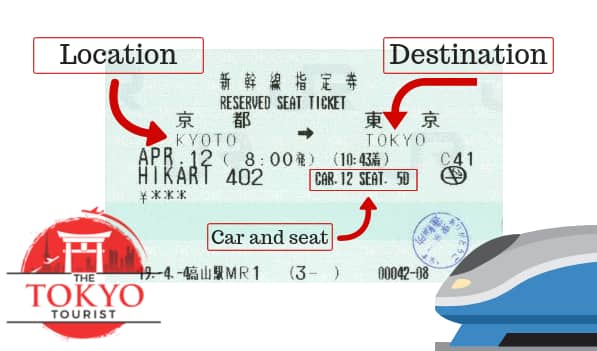
When Should I Buy My JR Pass?
If you’re anything like me, you like to get your business in order as early as possible. I’m big on reading guides and planning, but here you’ll actually have to be careful not to buy your JR Pass too early. You have to turn in your exchange voucher within 90 days of the purchase. This is a crucial point so let me repeat: You have to activate your Japan Rail Pass no later than three months (90 days) after your purchase it. If you decide to buy your JR Pass online on 1 January, you have to be in Japan to activate it before 1 April.
In general, it’s good to plan ahead, but in this case, there’s something called “too far ahead.” So be sure not to make this mistake!
Which Trains Are The Japan Rail Pass Valid On?
You can use your JR Pass on every train operated by the Japan Railways Group with two exceptions. The JR Pass is not valid for rides on Nozomi, and Mizuho trains on the Shinkansen network (bullet trains). This isn’t a big problem and let me tell you why.
If you’re going from Tokyo to Kyoto, you cannot take the Nozomi train, but you can take Hikari and Kodama.
Nozomi: 2 hours and 20 minutes
Hikari: 2 hours and 40 minutes
Kodama: 3 hours 40 minutes.
Hikari is not as fast as Nozomi, but it’s still pretty fast with it’s operating speed of 185 mph (300 km/h)!
To get an idea of the Japan Railways Group’s coverage you can check out this Nationwide Route Map.
You can check out the Shinkansen network on the Bullet Train Railway Map.
Can You Use The Japan Rail Pass On non-JR Trains?
Yes, there are actually a few non-Japan Railways lines where you can use your JR Pass.
- The IR Ishikawa Railway Line between Kanazawa and Tsubata
- The Ainokaze Toyama Railway Line between Toyama and Takaoka
- The Aoimori Railway services between Aomori and Hachinohe
All of these lines have some special conditions with set limitations on which stations you can disembark on. So before you jump on any of these trains, I would ask the staff to help you out because this one can be a bit tricky.
Can You Use The Japan Rail Pass On Other Transport Than Trains?
Yes, it even works with a ferry! The JR West Miyajima Ferry. I’ve never used it myself, but it’s pretty cool that it’s covered.
The JR Pass also covers the Tokyo Monorail, which is the best way to get to Tokyo from Haneda Airport.
And lastly, the Japan Rail Pass covers some JR Bus lines, but not the express buses. This is subject to constant change, so you, unfortunately, need to look it up when you’re there.
How Much I Saved when I Used the Japan Rail Pass
Just to give you an example of how powerful the Japan Rail Pass can be I went ahead and retraced all my train journeys from a four week long stay I had in Japan in 2012. I, of course, know I saved a lot of money using the JR Pass, but I’ve never actually calculated exactly how much.
During my four weeks in Japan, I decided to get a 14 day JR Pass and condense most of my train journeys (especially with Shinkansen!) to the 14-day period my rail pass was active.
I’ve translated all of the prices into 2018 prices (including the JR Pass itself). During my 14 day period I undertook these train journeys:
| From | To | Fare |
| Narita Airport | Tokyo | ¥3,190 |
| Tokyo | Kyoto | ¥13,400 |
| Kyoto | Nara | ¥710 |
| Nara | Kyoto | ¥710 |
| Kyoto | Osaka | ¥560 |
| Osaka | Hiroshima | ¥10,030 |
| Hiroshima | Hakata | ¥8,740 |
| Hakata | Kyoto | ¥15,440 |
| Kyoto | Tokyo | ¥13,400 |
| Tokyo | Nagano | ¥8,000 |
| Nagano | Akita | ¥21,120 |
| Akita | Tokyo | ¥17,460 |
| Tokyo | Yokohama | ¥470 |
| Yokohama | Kamakura | ¥470 |
| Kamakura | Tokyo | ¥920 |
That was a couple of intense weeks. If I didn’t have a Japan Rail Pass, the total cost would be ¥114,620 ($1 030). With a JR Pass, it only cost me ¥46,390 ($414). That’s a saving of ¥68,320 which is over $600!
How To Plan Your Travel Itinerary
HyperDia is a great way to plan your train journeys. They also have an app, but I like the website a lot better. When you use HyperDia to plan out your travel itinerary with your JR Pass you have to remember to uncheck Private Railway and Nozomi / Mizuho as they’re not covered by the pass. Out of convenience I also uncheck Airplane, so I don’t get any unnecessary route outputs.
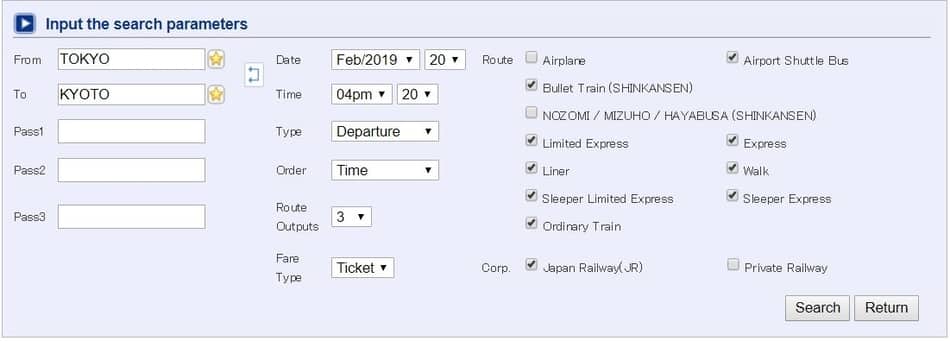
Japanese Train Etiquette
Most of it should be common sense, but you might be a bit surprised by some of these.
- Always let people disembark before you board
- Only smoke in smoking rooms
- Be quiet, make as little noise as possible
- There’s something called priority seating, and unless you are elderly, disabled or pregnant you should not use those seats
- Do not talk on your cell phone
- Do not eat on short train rides as it’s frowned upon (it’s OK to do on Shinkansen)
Some of these might seem a bit extreme but remember that Japan is a very polite and collectivistic society. The reason it’s rude to talk on your cell phone or to talk in a loud voice with your partner is that it may bother the people around you. Think of the people around you, and you’ll do fine.
A Quick Japan Rail Pass Q&A/FAQ
Do I have to start using my Japan Rail Pass as soon as I collect it?
No, you set a “first day of use date.” The start date can be up to 30 days from the day you collect it.
Can I use the JR Pass in the electric turnstiles?
No, you have to go through the operated booth and show your pass to the staff. It only takes a couple of seconds.
Is it possible to reserve seats online?
No, unfortunately not!
Does it matter at which time I start using my JR Pass?
No, its duration is from midnight to midnight. If you activate your pass January 1, it’s valid to January 7 11:59 p.m.
Can I use the JR Pass on the subway/metro?
No, the Tokyo Metro is not Japan Railways.
Can I use the JR Pass on trains within Tokyo?
Yes!! You can use the pass on trains within Tokyo. There’s actually an extensive network of JR Trains running within the city so be sure to use the JR trains when your JR Pass is active.
Can I Use the JR Pass on Narita Express?
Oh yes!
Is it possible to get a Japan Rail Pass discount?
No, the prices are fixed, and no discounts are available.
Is a green JR Pass worth it?
I prefer the green (1st class) pass, but sometimes I want to save money, so I buy the standard one. It works just fine, but it’s not as good as access to the green cars.
Can I use someone else’s JR Pass?
No, this is strictly forbidden. The JR Pass can only be used by the person whose name is on the pass.
What happens if I lose my exchange voucher/JR pass?
Then you are in trouble because lost vouchers/JR Passes will not be reissued.
Can I skip a day where I don’t travel and get the pass duration extended?
No, but it would be great though! From the first day of use, the pass expires after 7/14/21 days no matter how much you use it.
Conclusion
The Japan Rail Pass is definitively worth it if you plan on traveling a fair bit by train. Especially if you have a few Shinkansen journeys lined up. If you’re going from Tokyo to Kyoto and back, along with some other train journeys, you will probably save money with a Japan Rail Pass. But f you’re only staying in Tokyo the Japan Rail Pass is NOT worth it. Use HyperDia to plan your itinerary and it’ll be easy to see if a Japan Rail Pass is worth it to you.
If you don’t need a Japan Rail Pass and only want to find out the cheapest and fastest ways of getting from Tokyo to Kyoto and Tokyo to Osaka, you can check out these articles:
Did I miss anything? Let me know in the comments down below.
